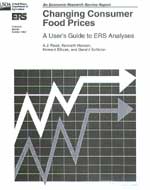Changing Consumer Food Prices: A User's Guide to ERS Analyses
- by Albert Reed, Kenneth Hanson, Howard Elitzak and Gerald Schluter
- 6/1/1997
Overview
ERS uses different economic models to estimate the impact of higher input prices on consumer food prices. This technical bulletin compares three ERS models. In the first two models (referred to as shortrun models), neither consumers nor food producers respond to market prices. In the third model (a longrun model), both consumers and food producers respond to changing prices. The authors simulated the impact of a higher energy price on consumer food prices. The empirical findings are consistent with expected market responses. In the short run, the effect of an increase in the price of energy is fully (or nearly fully) passed on to consumers, because neither food producers nor consumers can immediately respond to changing prices. In the long run, however, the price response of food producers and consumers serves to mitigate the increase in consumer food prices.
Download
-
Entire report
Download PDF
We’d welcome your feedback!
Would you be willing to answer a few quick questions about your experience?

